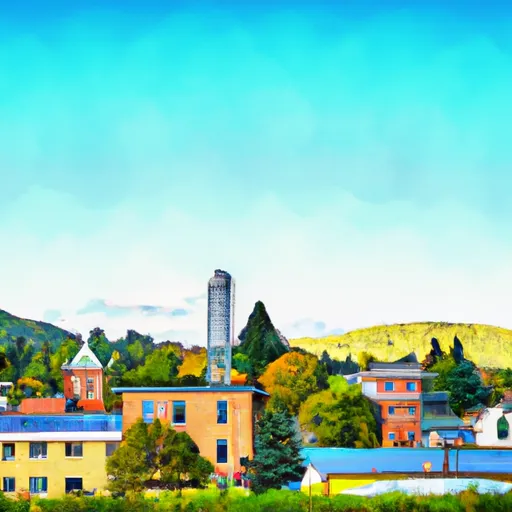-
 Snoflo Premium
Snoflo Premium
Get unlimited access to all our content
With no Ad interruptions! - Start Your Free Trial Login with existing account
Graniteville
Eden Index
Climate
7.2
•
Recreation
3.4
•
Community
2.7
•
Safeguard
4.8/10

Graniteville is a small village located in the town of Barre, Vermont. The climate is characterized by cold winters and warm summers, with average temperatures ranging from 10°F in January to 70°F in July. The area is surrounded by forests and wetlands and is home to several streams and rivers, including the Stevens Branch, which flows through the village. Water quality in the area is monitored for hydrology constituents such as bacteria, pH, and turbidity. Outdoor recreation opportunities in Graniteville include hiking and biking in nearby state parks, fishing in local streams, and skiing and snowboarding at nearby resorts in the winter.
What is the Eden Index?
The Snoflo Eden Index serves as a comprehensive rating system for regions, evaluating their desirability through a holistic assessment of climate health, outdoor recreation opportunities, and natural disaster risk, acknowledging the profound impact of these factors on livability and well-being.
Climate Health Indicator (CHI): 7.2
Graniteville receives approximately
1094mm of rain per year,
with humidity levels near 79%
and air temperatures averaging around
6°C.
Graniteville has a plant hardyness factor of
4, meaning
plants and agriculture in this region thrive during a short period during spring and early summer. Most
plants will die off during the colder winter months.
By considering the ideal temperature range, reliable water supplies, clean air, and stable seasonal rain or snowpacks, the Climate Health Indicator (CHI) underscores the significance of a healthy climate as the foundation for quality living.
A healthy climate is paramount for ensuring a high quality of life and livability in a region, fostering both physical well-being and environmental harmony. This can be characterized by ideal temperatures, reliable access to water supplies, clean air, and consistent seasonal rain or snowpacks.
Weather Forecast
Streamflow Conditions
Richelieu
Area Rivers
Richelieu
Snowpack Depths
Richelieu
Reservoir Storage Capacity
Richelieu
Groundwater Levels
Recreational Opportunity Index (ROI): 3.4
The Recreational Opportunity Index (ROI) recognizes the value of outdoor recreational options, such as parks, hiking trails, camping sites, and fishing spots, while acknowledging that climate plays a pivotal role in ensuring the comfort and consistency of these experiences.
Access to outdoor recreational opportunities, encompassing activities such as parks, hiking, camping, and fishing, is crucial for overall well-being, and the climate plays a pivotal role in enabling and enhancing these experiences, ensuring that individuals can engage in nature-based activities comfortably and consistently.
Camping Areas
| Campground | Campsites | Reservations | Toilets | Showers | Elevation |
|---|---|---|---|---|---|
| Stillwater State Park | 62 | 1,129 ft | |||
| Elmore State Park | None | 1,637 ft | |||
| Big Deer State Park | 23 | 1,179 ft | |||
| Eden Rec Area | None | 1,251 ft | |||
| Quechee State Park | 55 | 638 ft | |||
| Silver Lake State Park | 40 | 1,385 ft | |||
| New Discovery State Park | 47 | 1,738 ft | |||
| Mt. Ascutney State Park | None | 518 ft | |||
| Allis State Park | 26 | 1,875 ft | |||
| Storrs Pond Rec Area | 30 | 591 ft |
Nearby Ski Areas
Catastrophe Safeguard Index (CSI):
The Catastrophe Safeguard Index (CSI) recognizes that natural disaster risk, encompassing floods, fires, hurricanes, and tornadoes, can drastically affect safety and the overall appeal of an area.
The level of natural disaster risk in a region significantly affects safety and the overall livability, with climate change amplifying these risks by potentially increasing the frequency and intensity of events like floods, fires, hurricanes, and tornadoes, thereby posing substantial challenges to community resilience and well-being.
Community Resilience Indicator (CRI): 2.7
The Community Resilience Indicator (CRI) recognizes that education, healthcare, and socioeconomics are crucial to the well-being of a region. The CRI acknowledges the profound impact of these elements on residents' overall quality of life. By evaluating educational resources, healthcare accessibility, and economic inclusivity, the index captures the essential aspects that contribute to a thriving community, fostering resident satisfaction, equity, and social cohesion.

